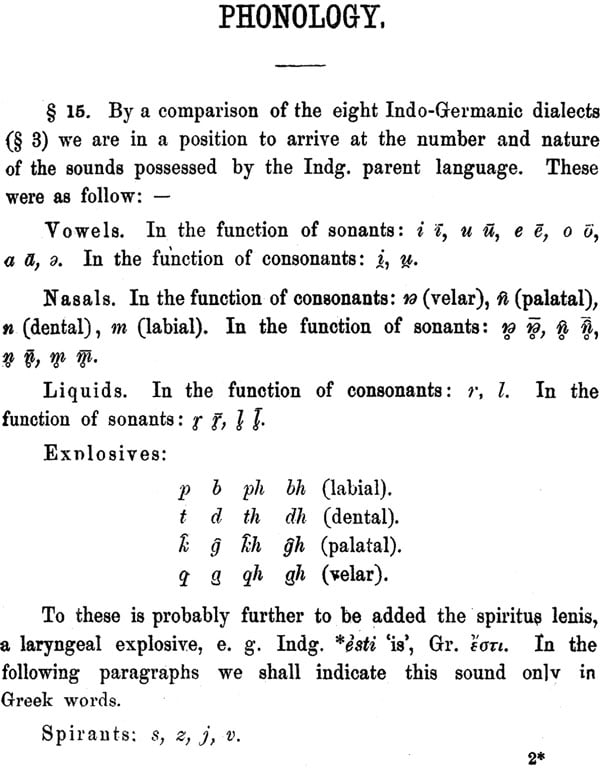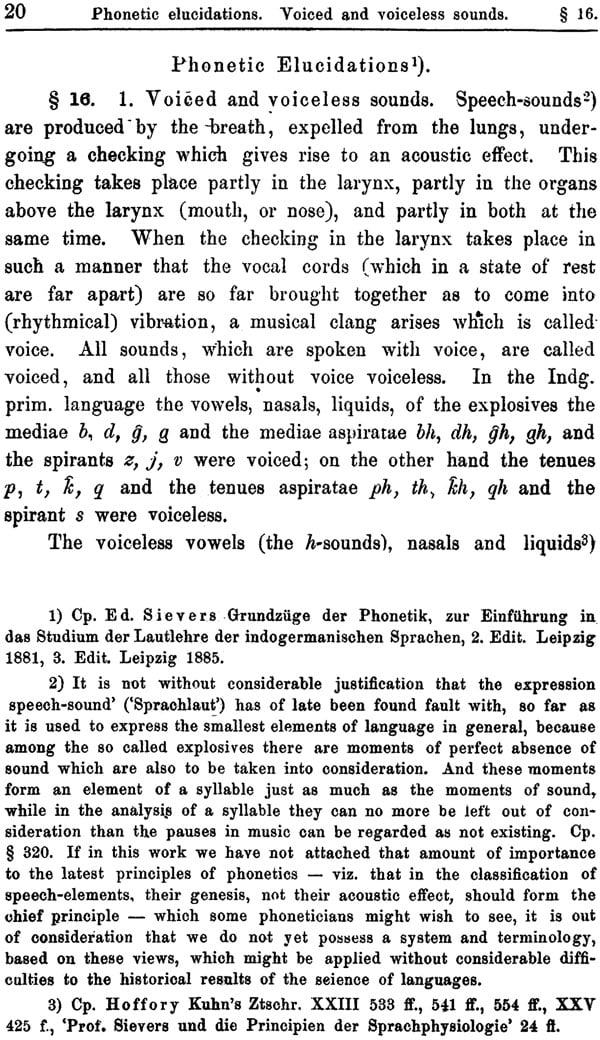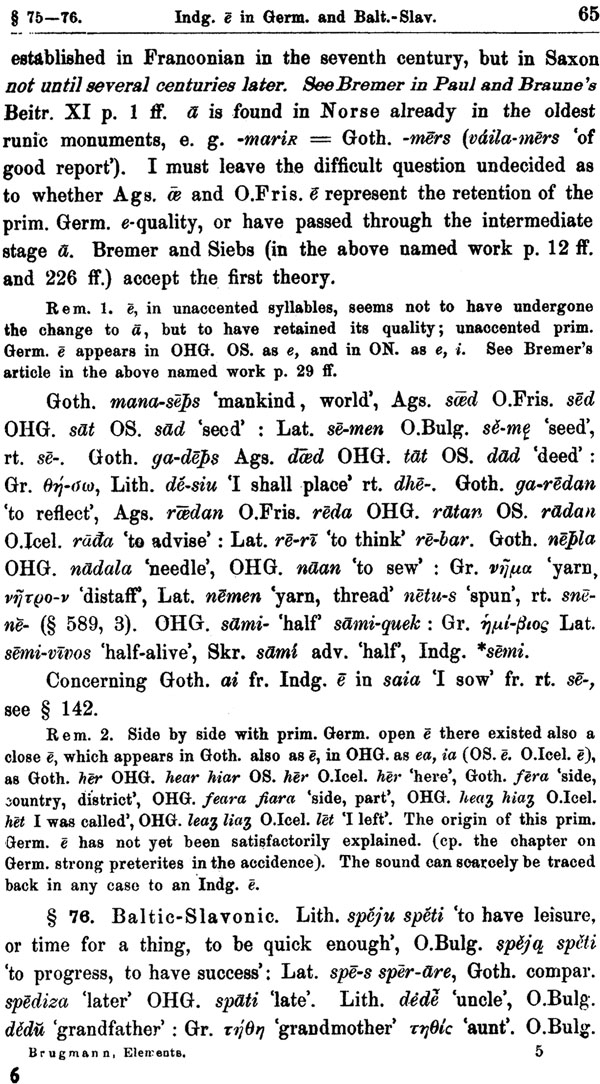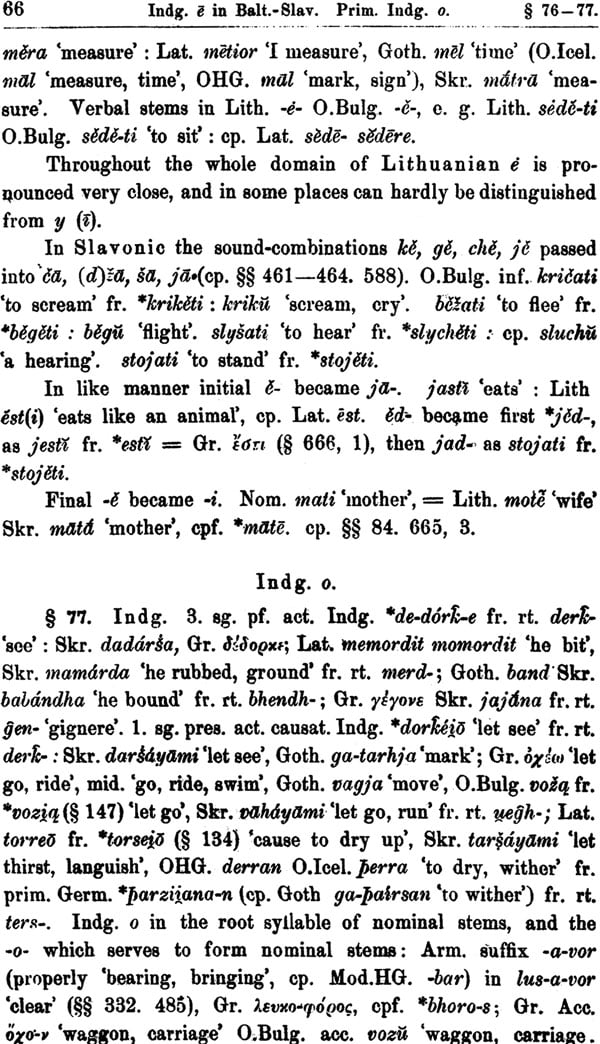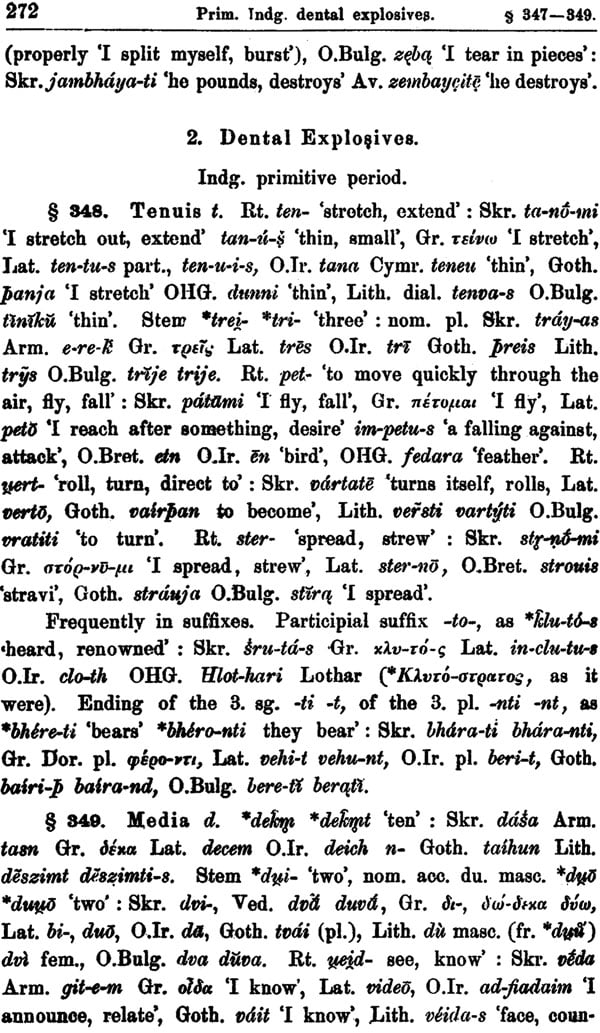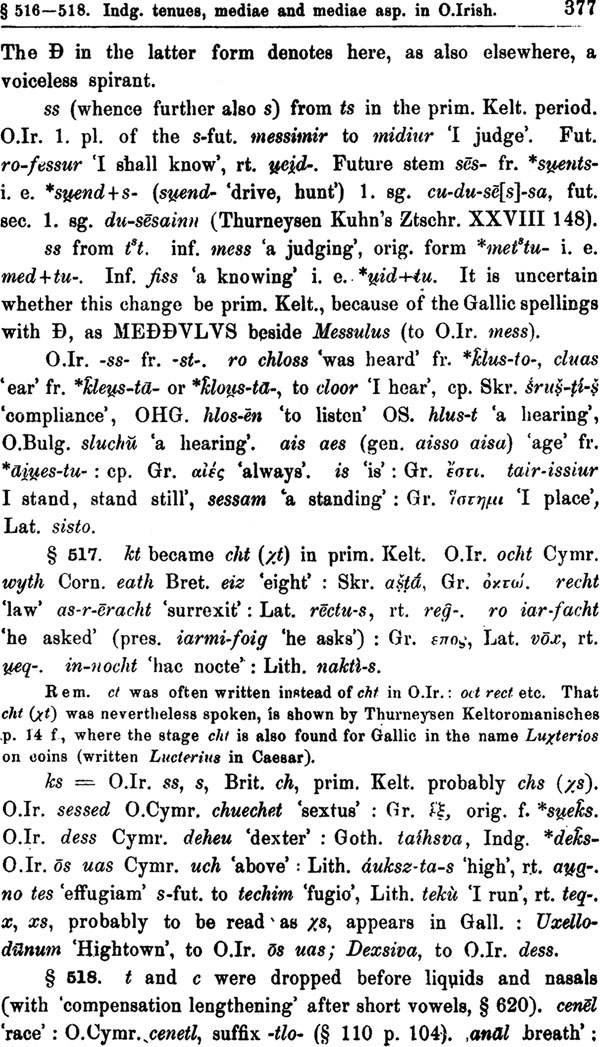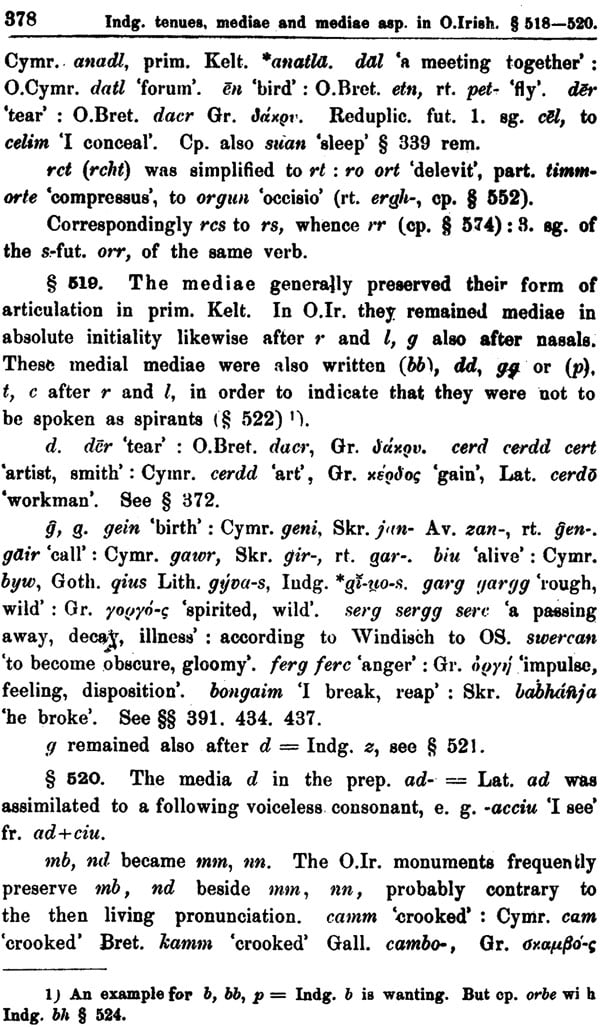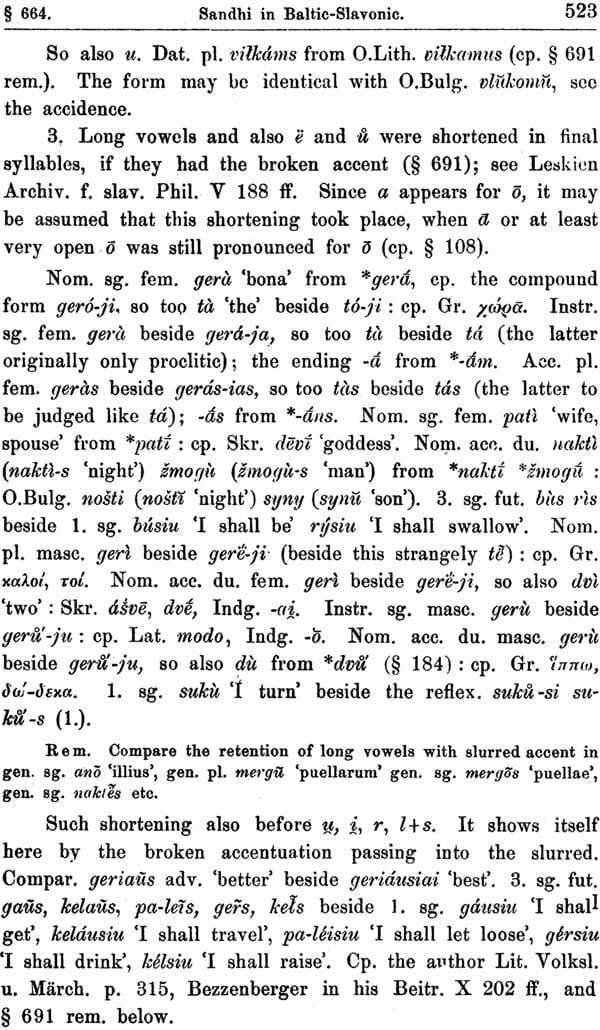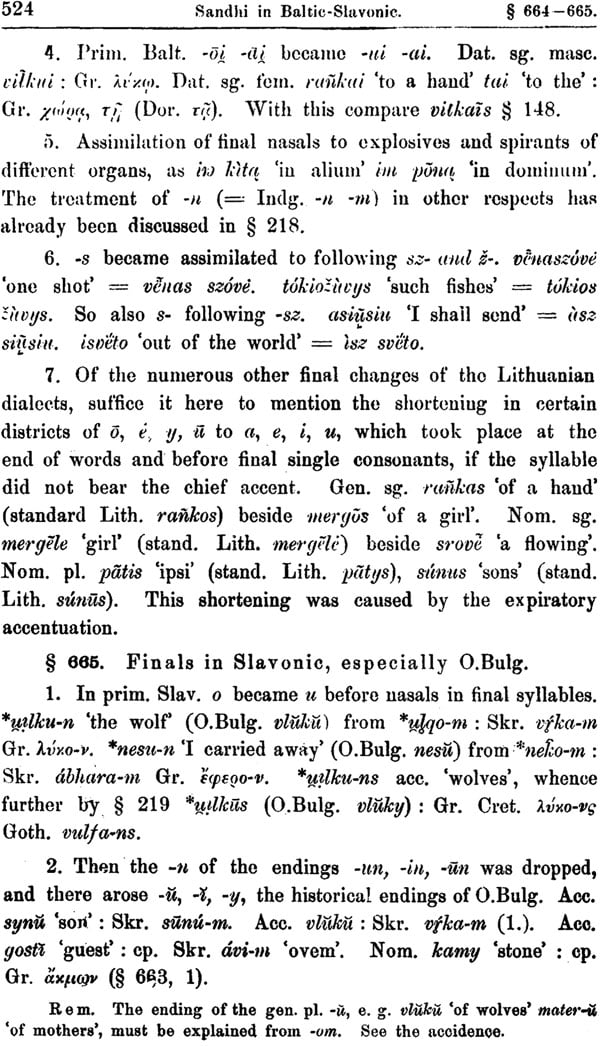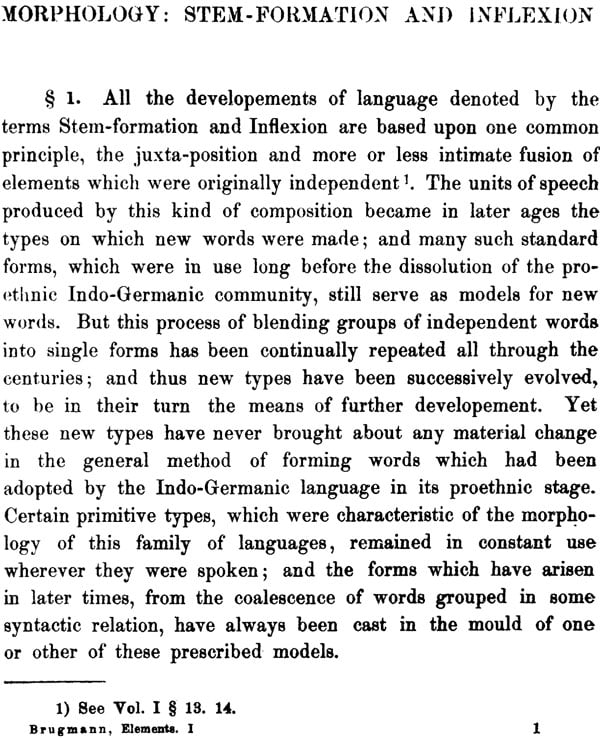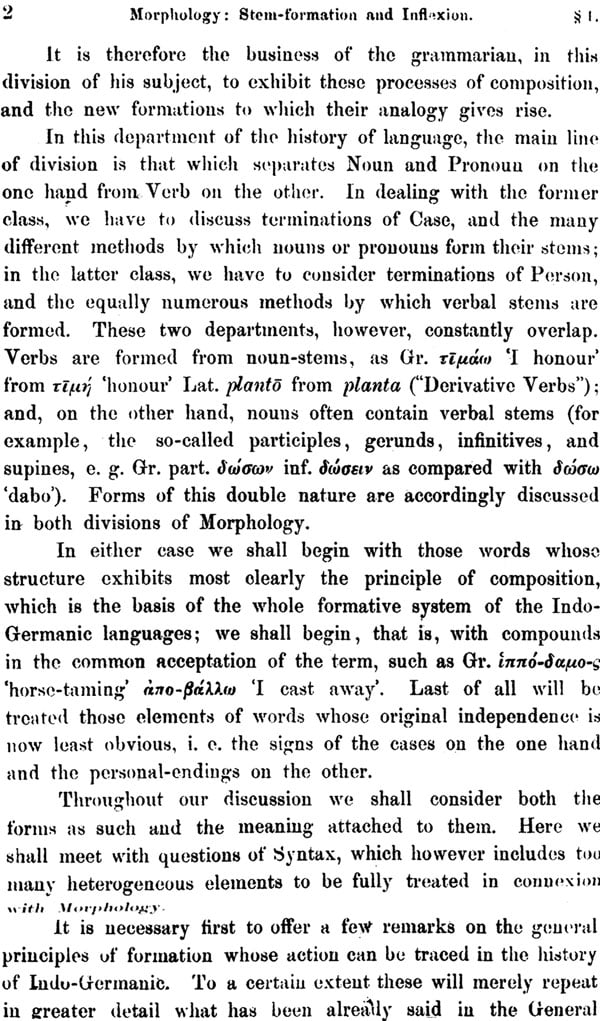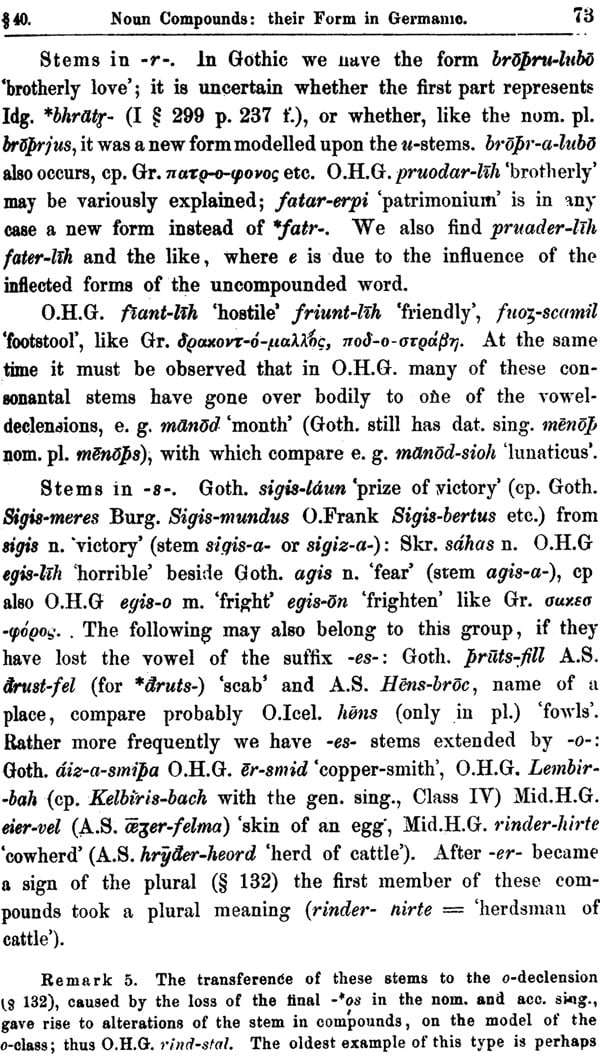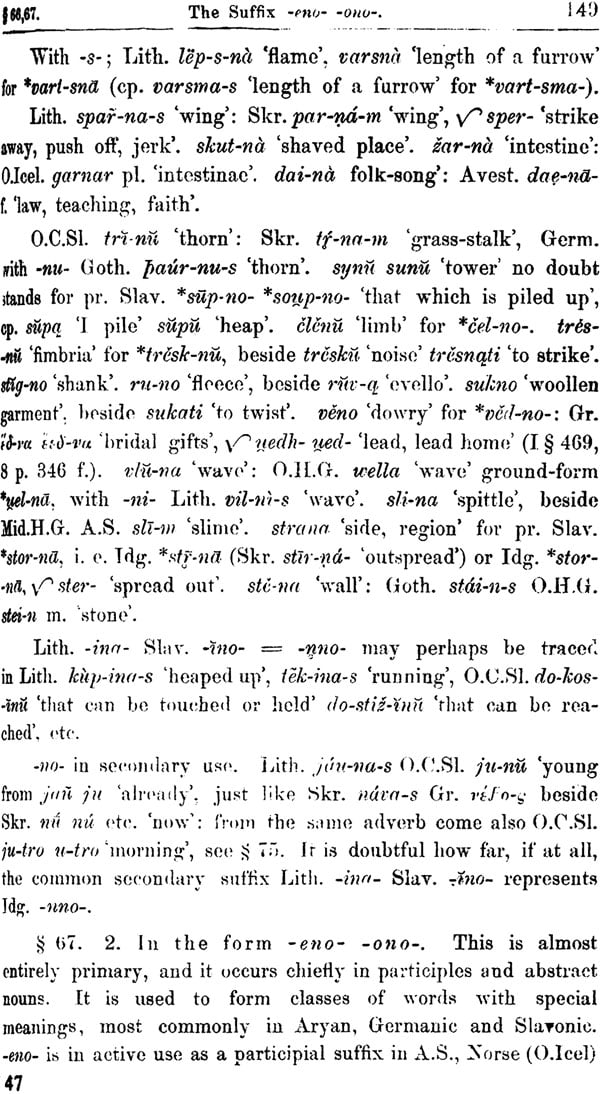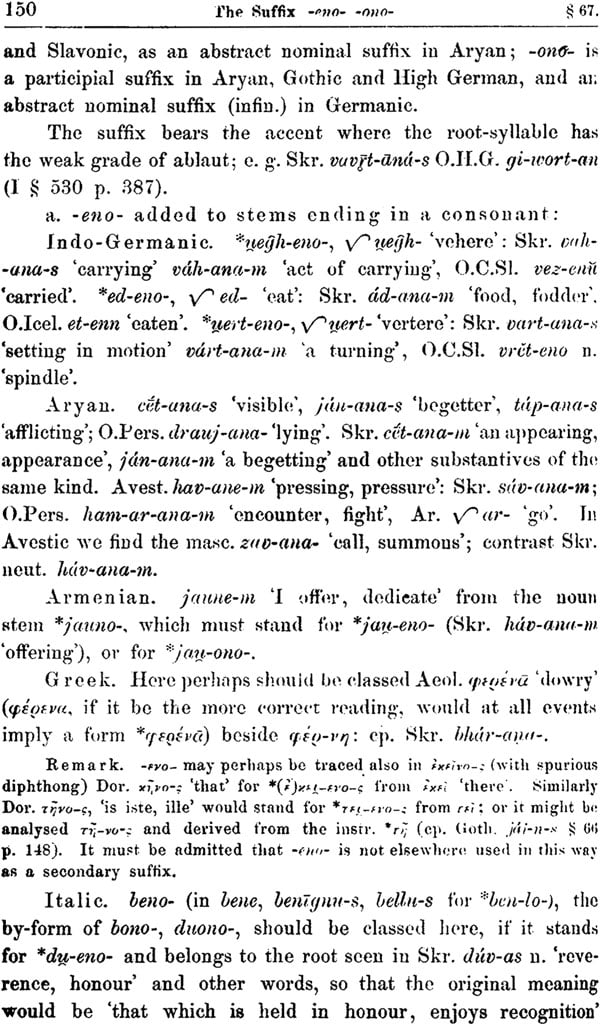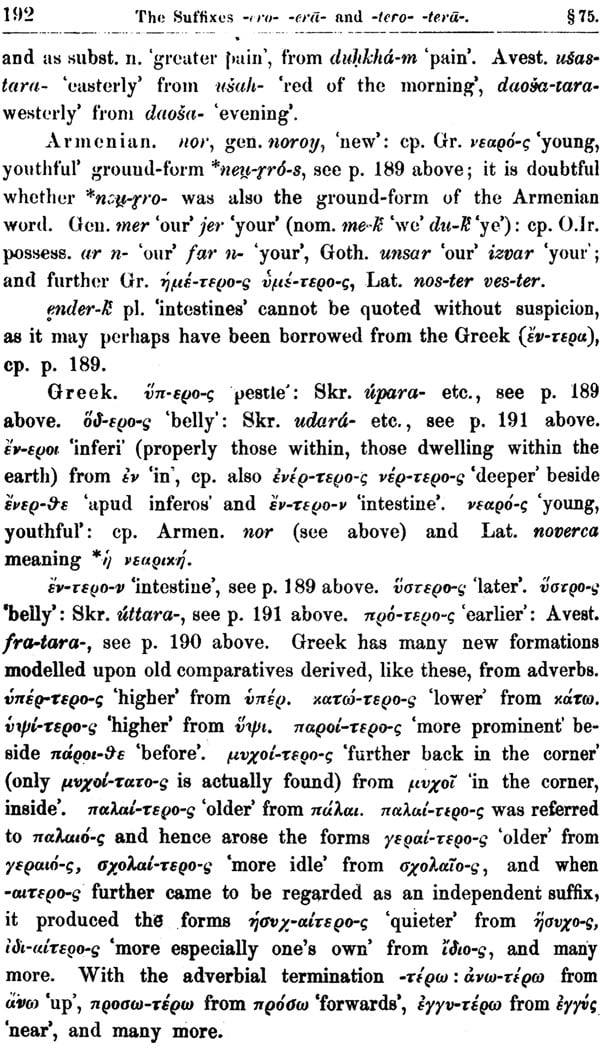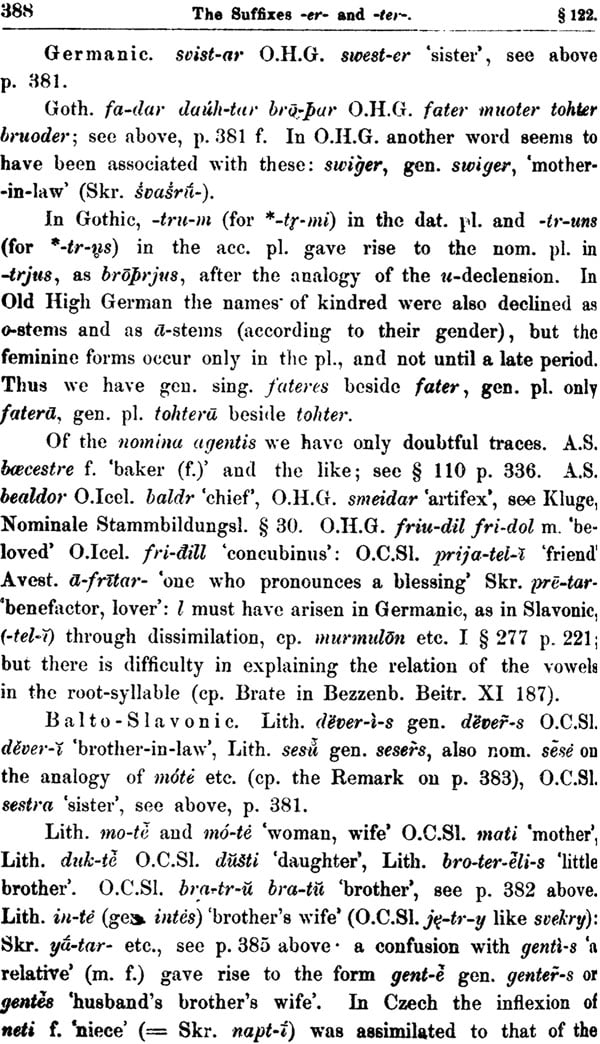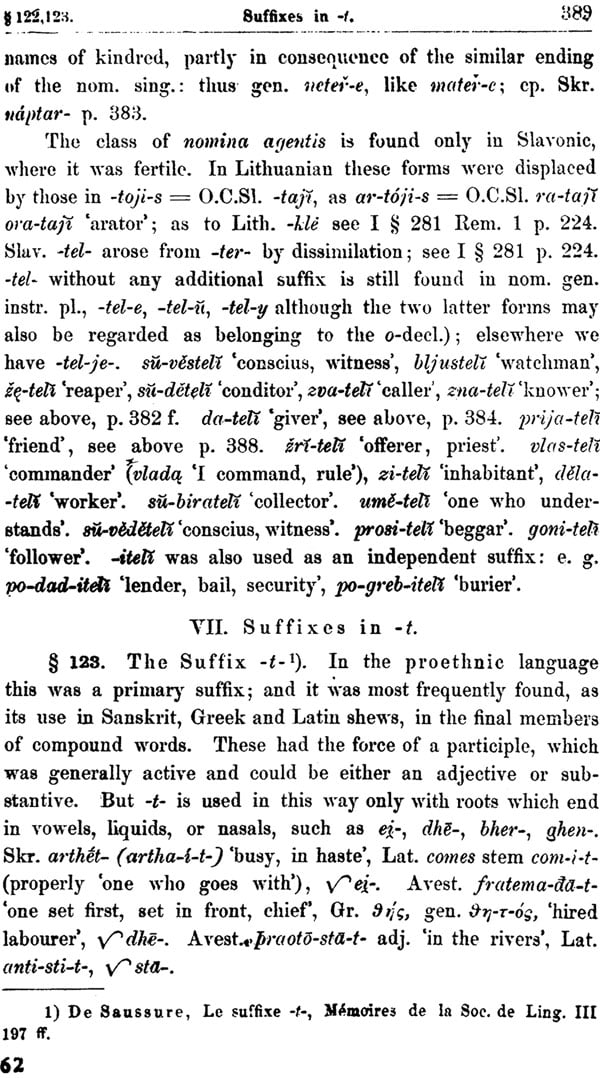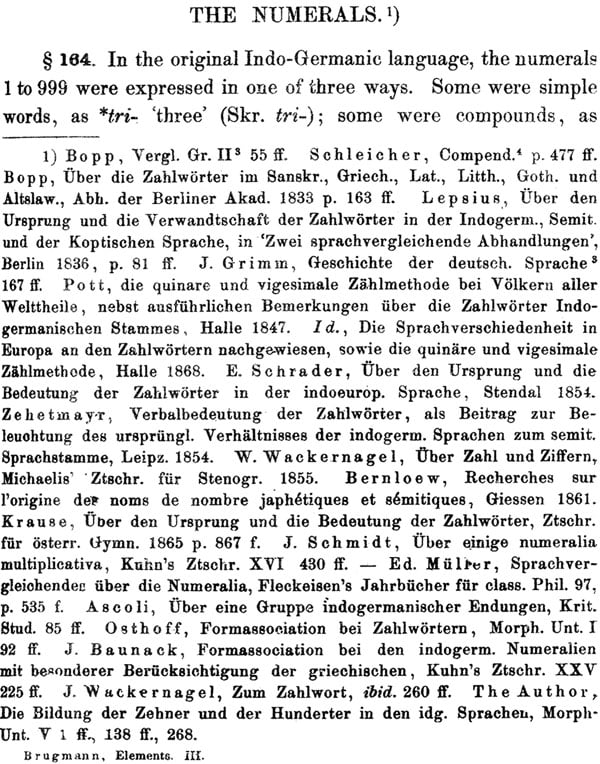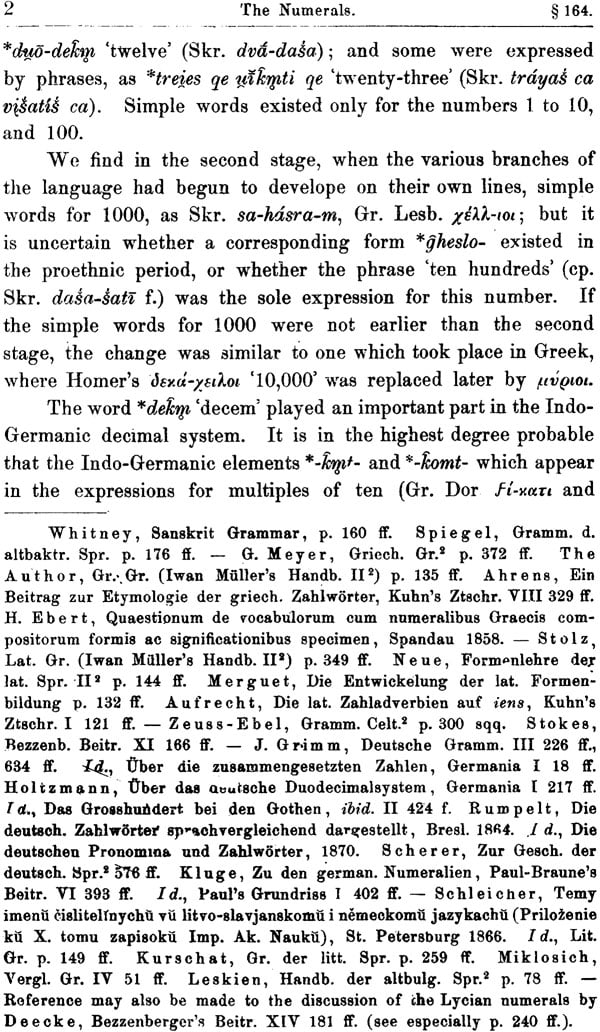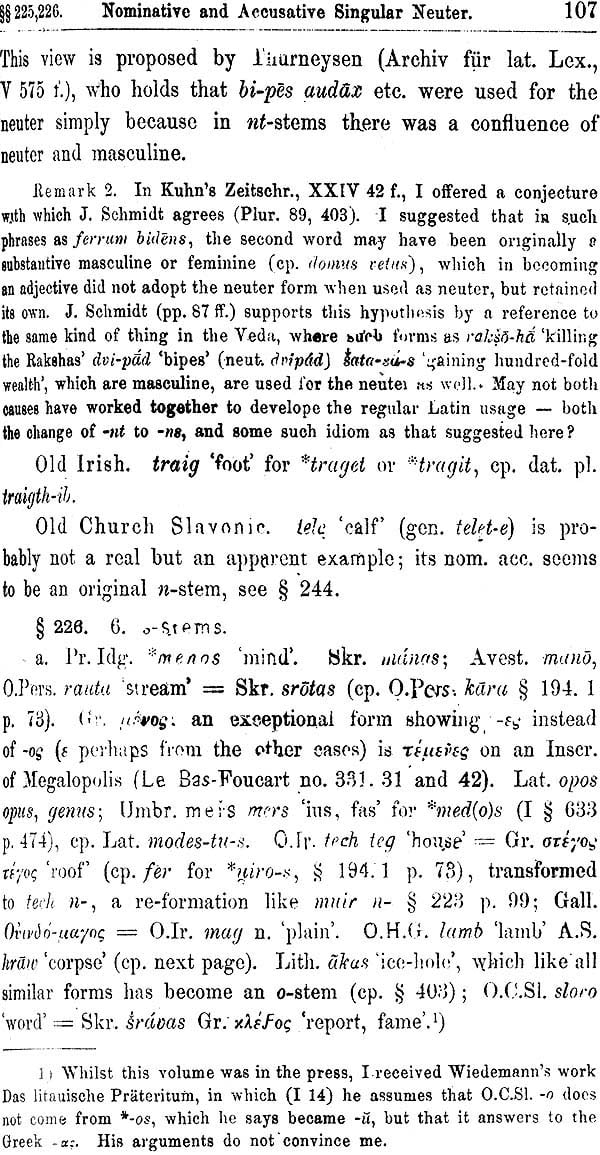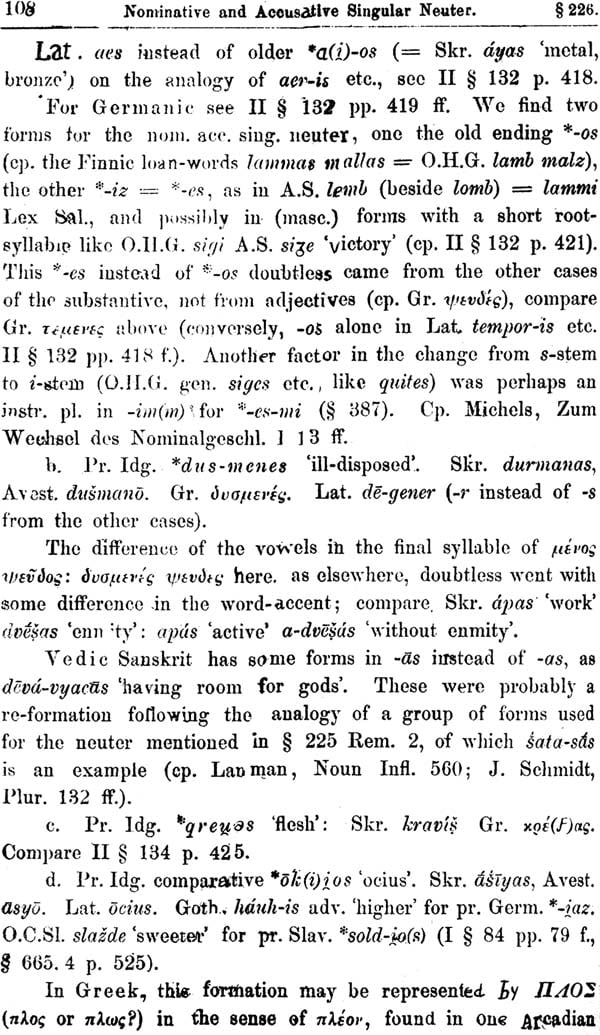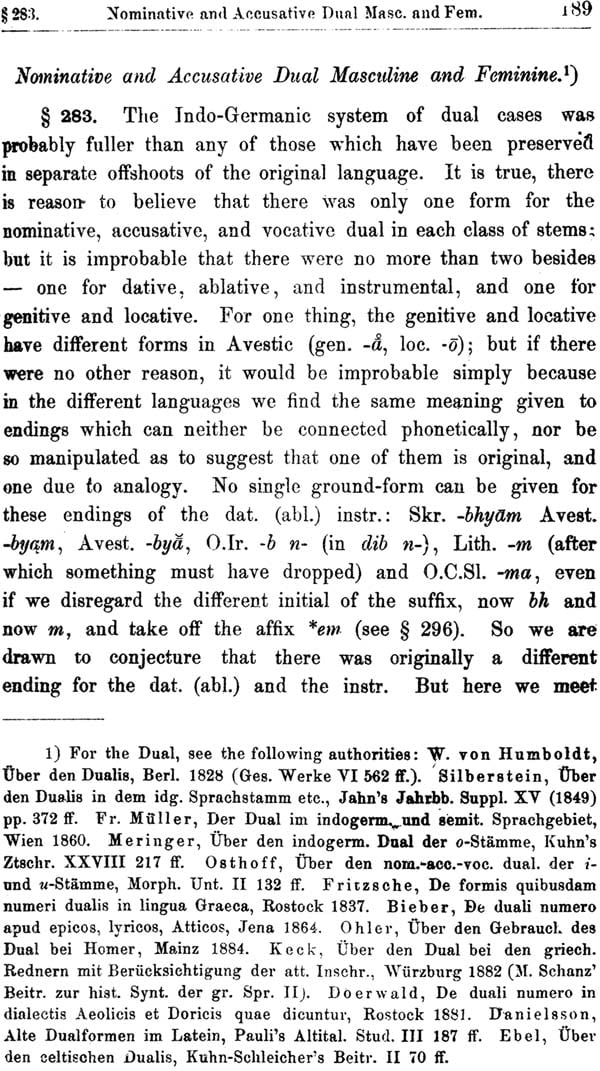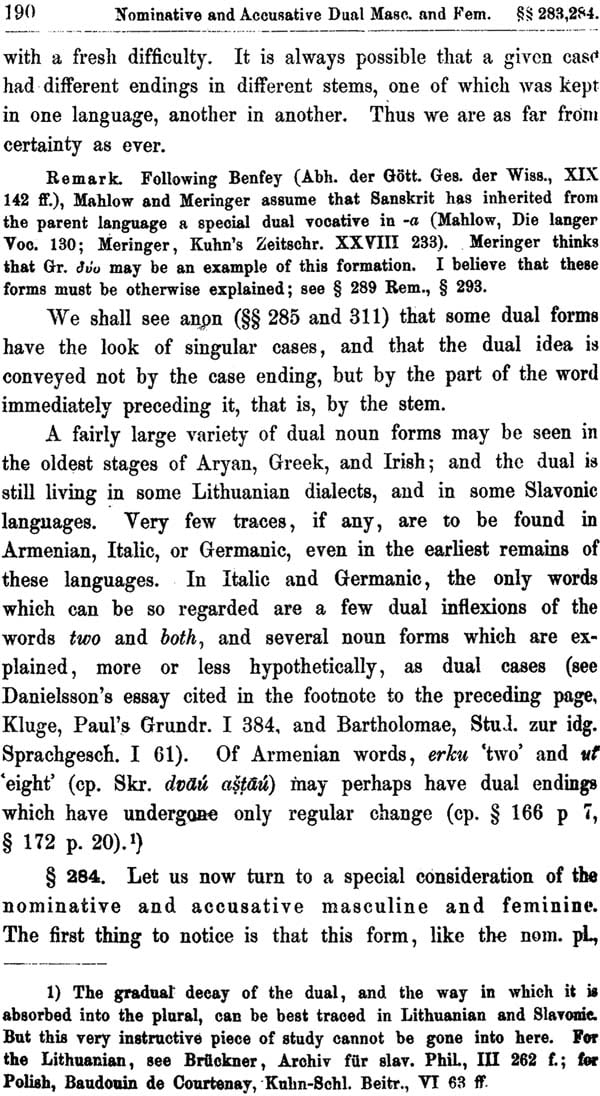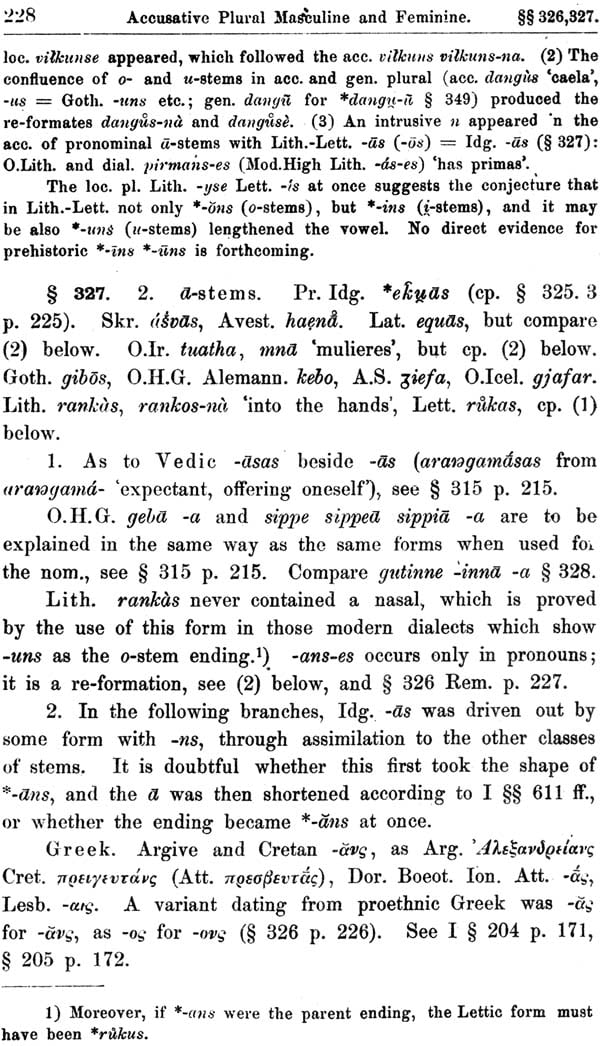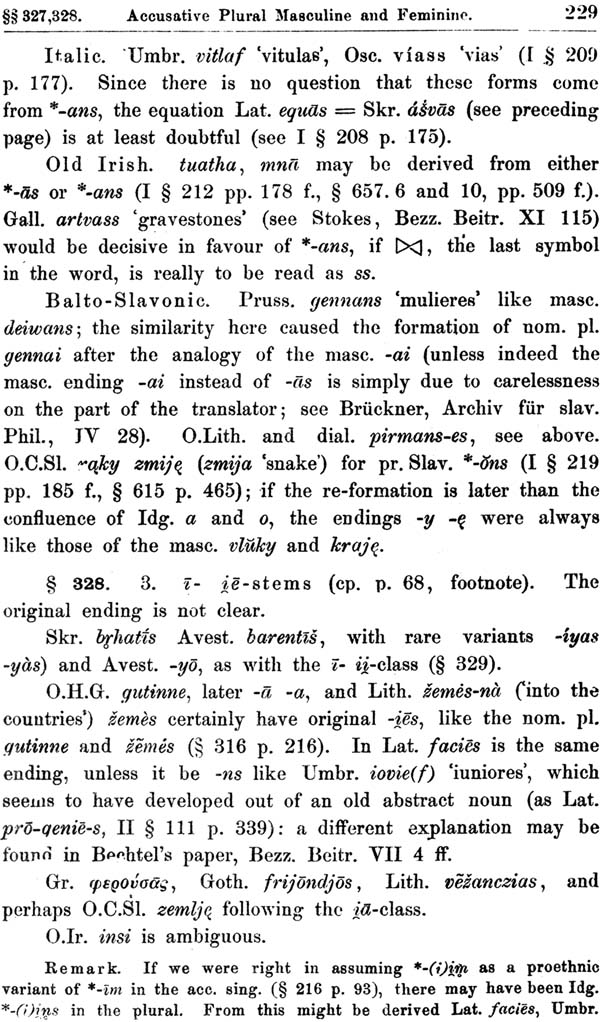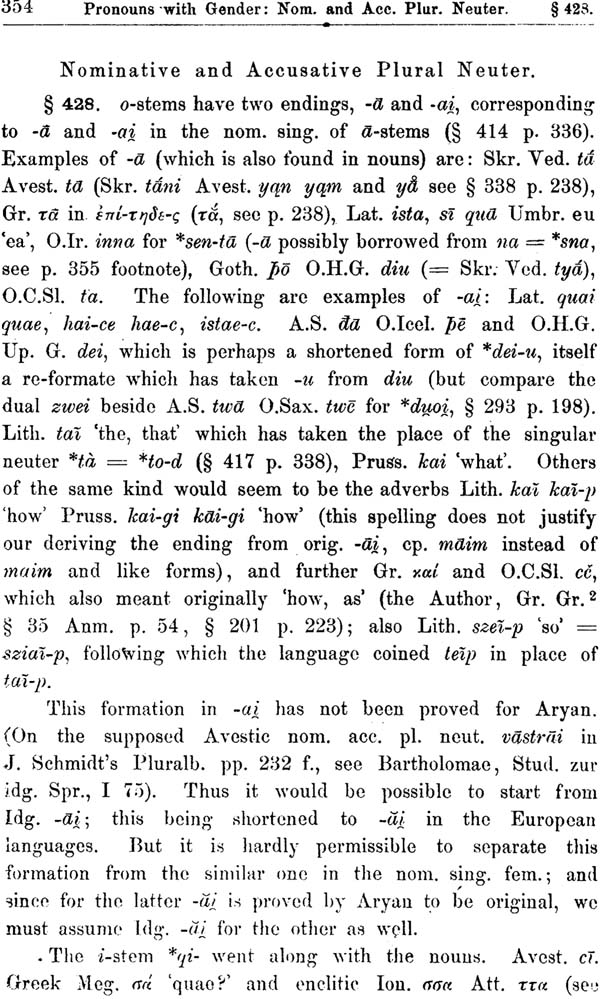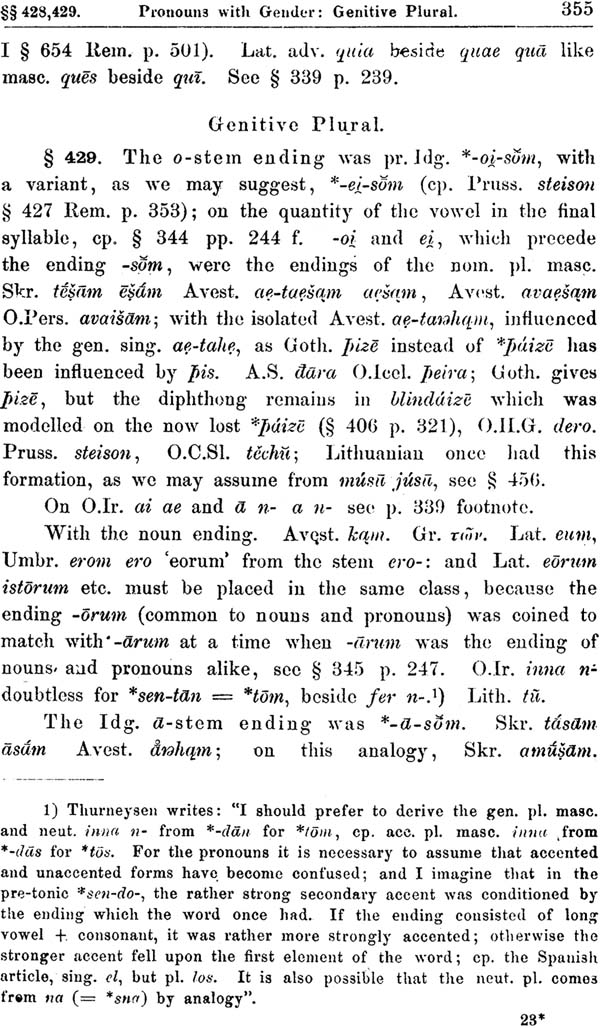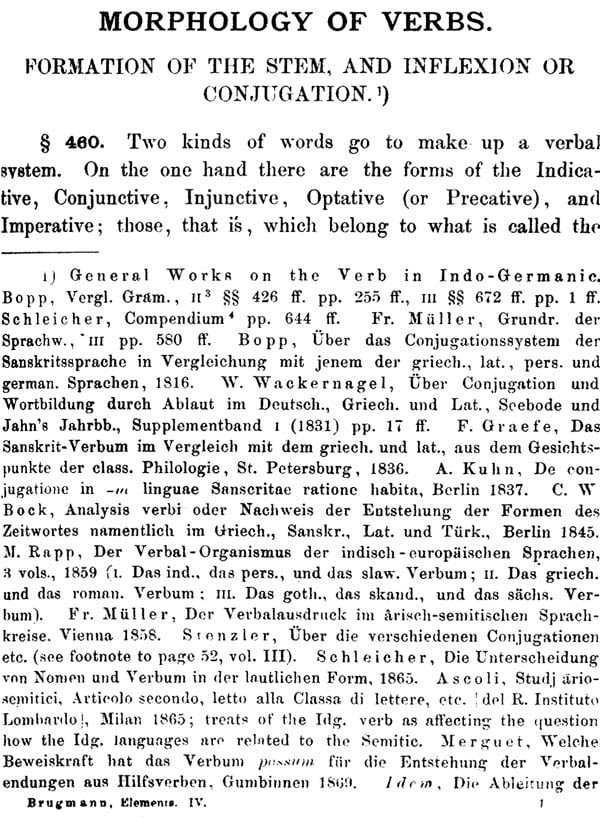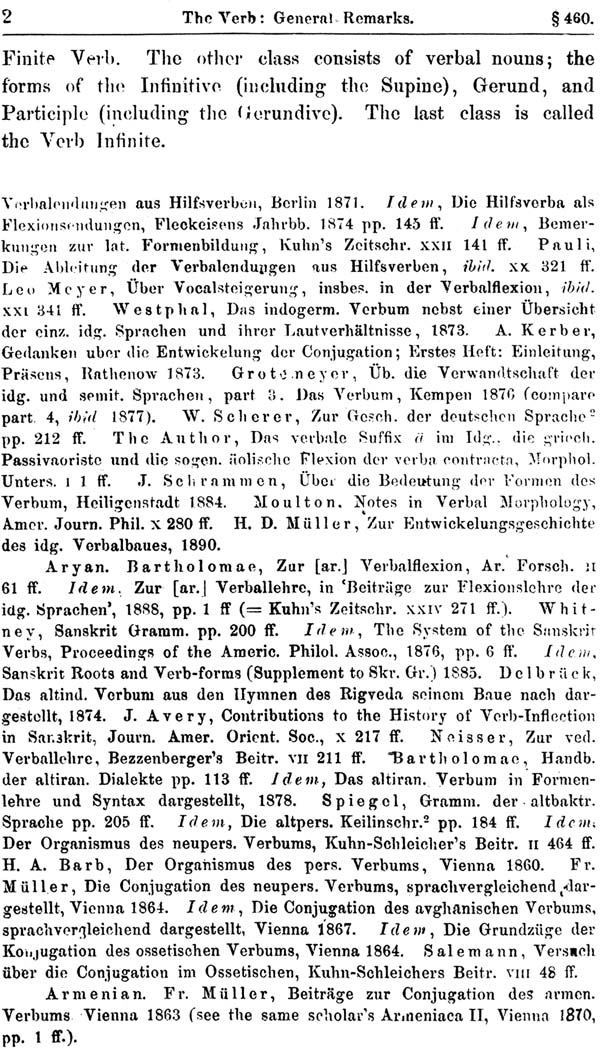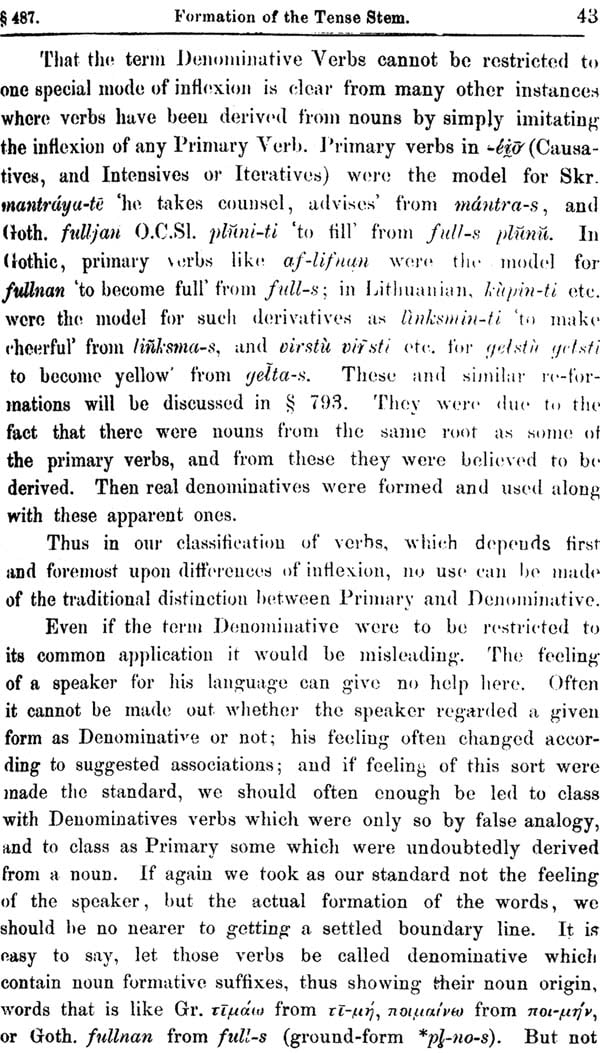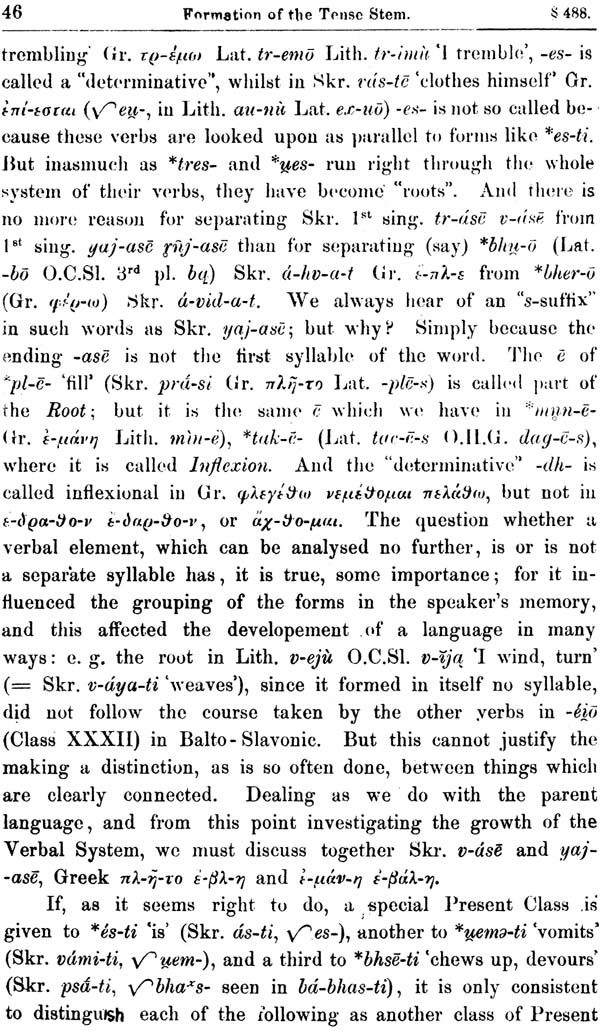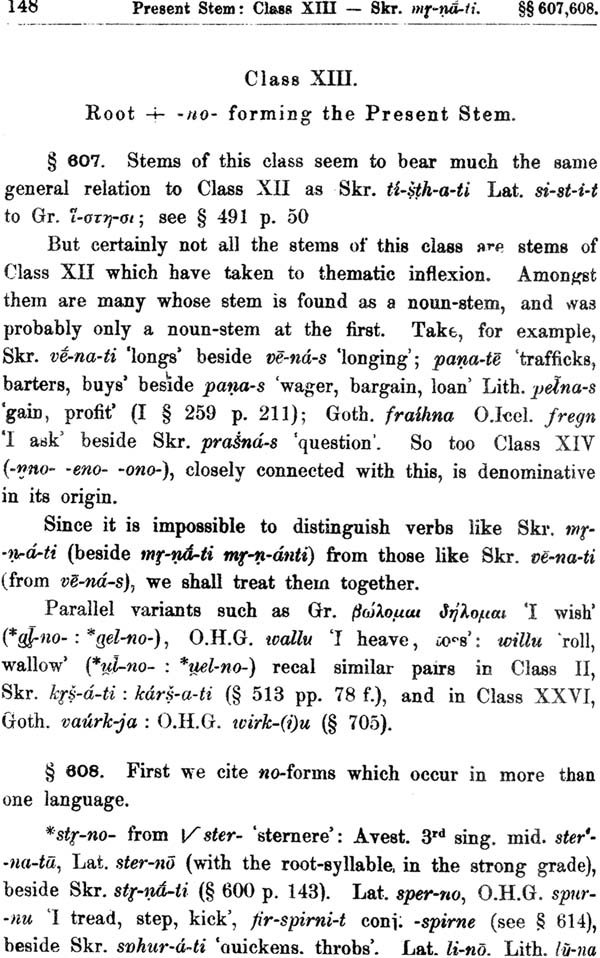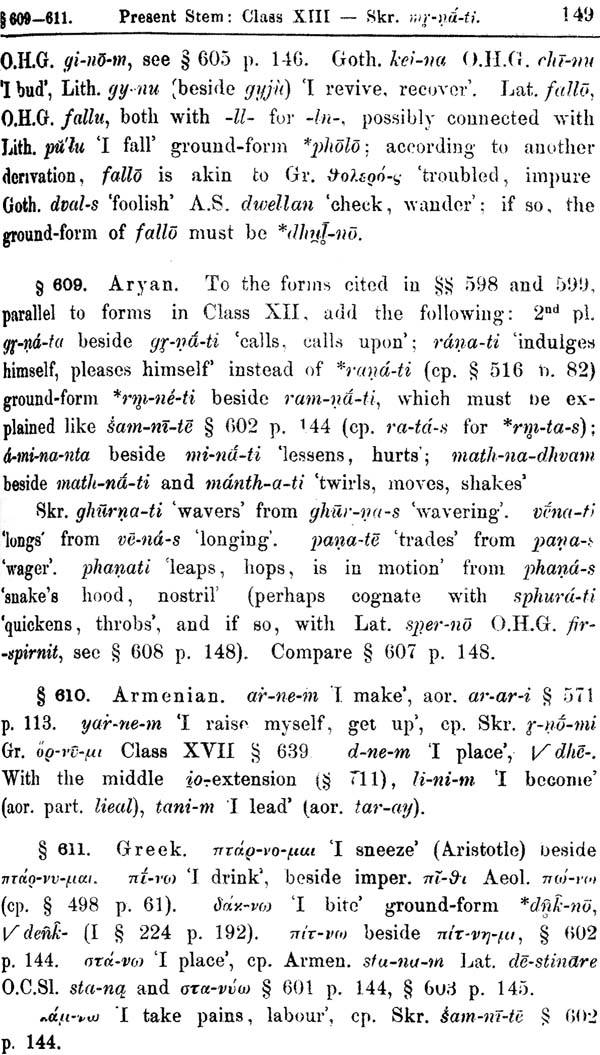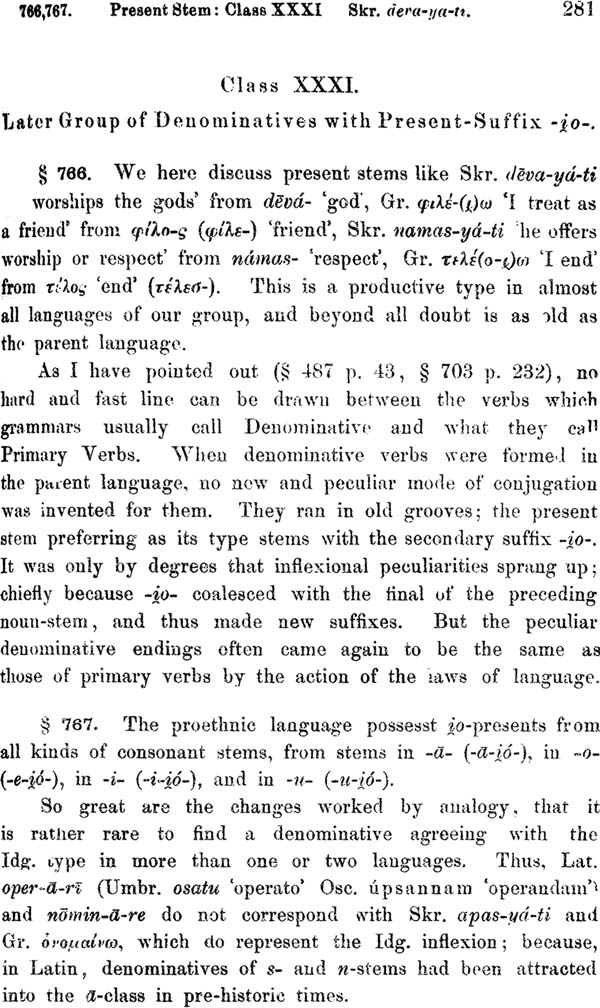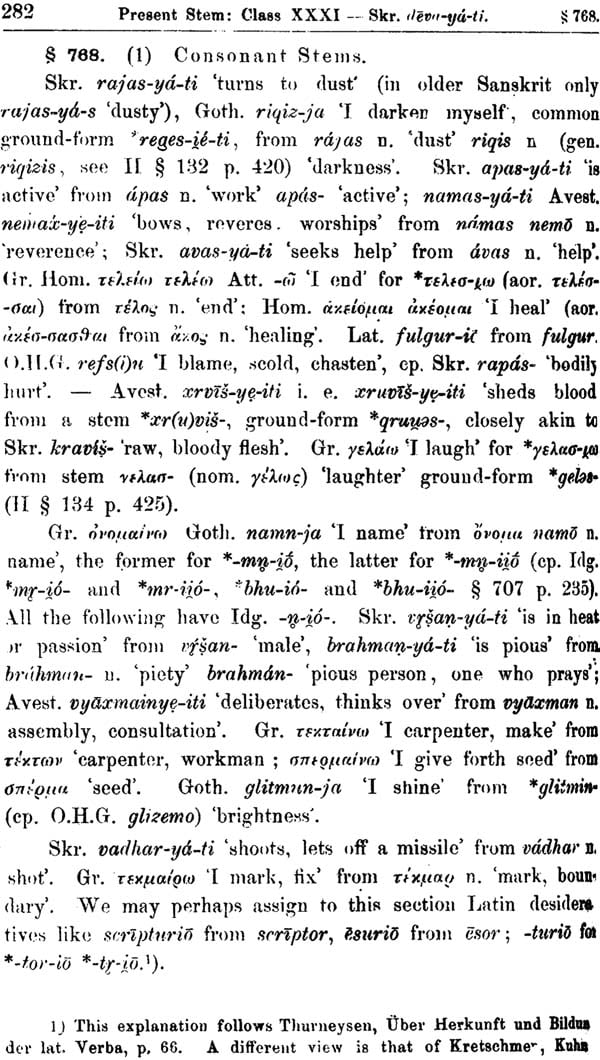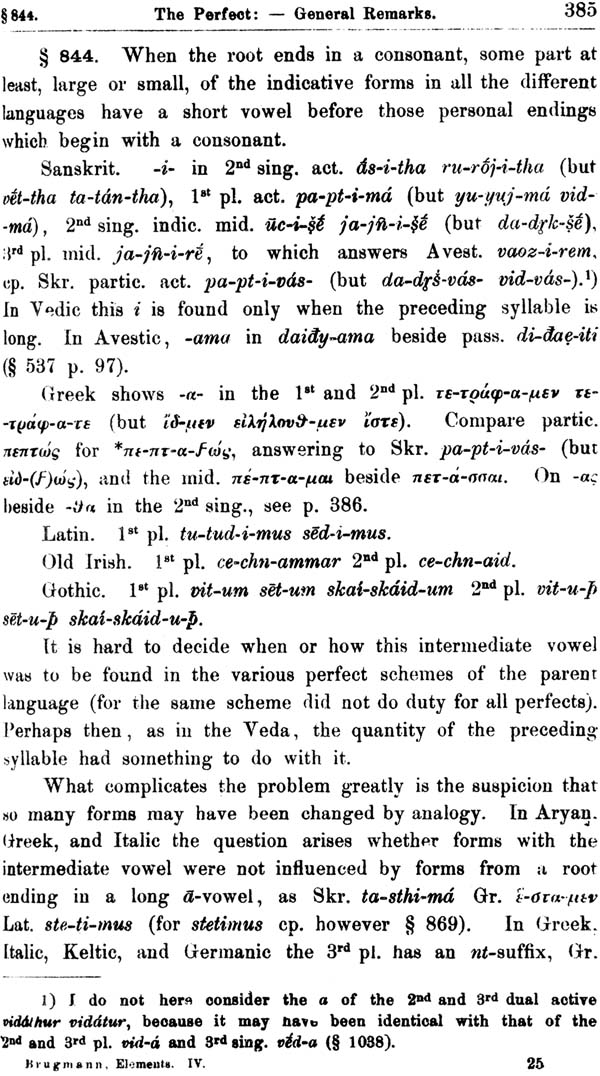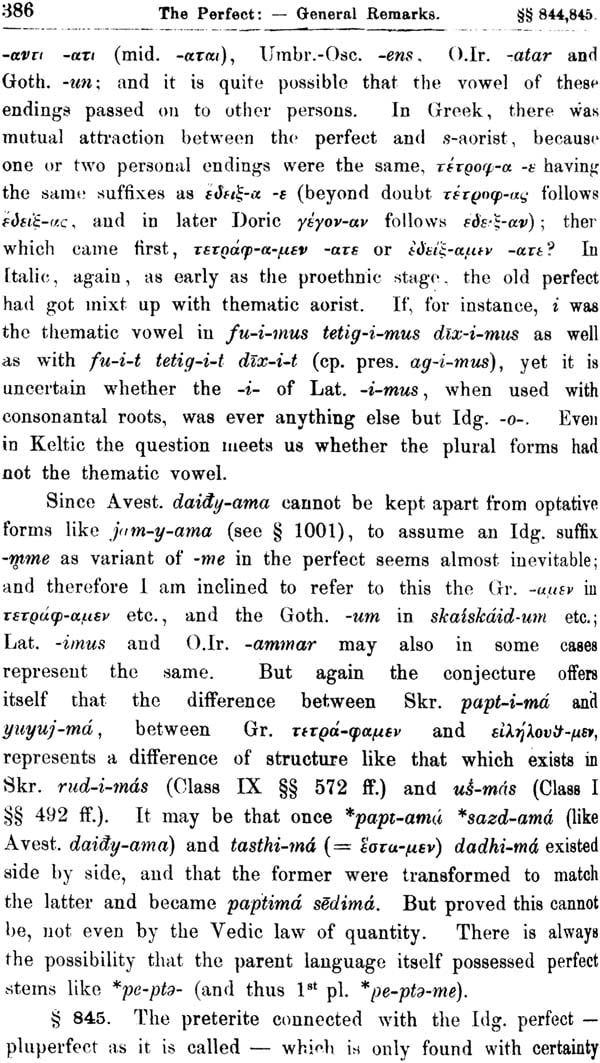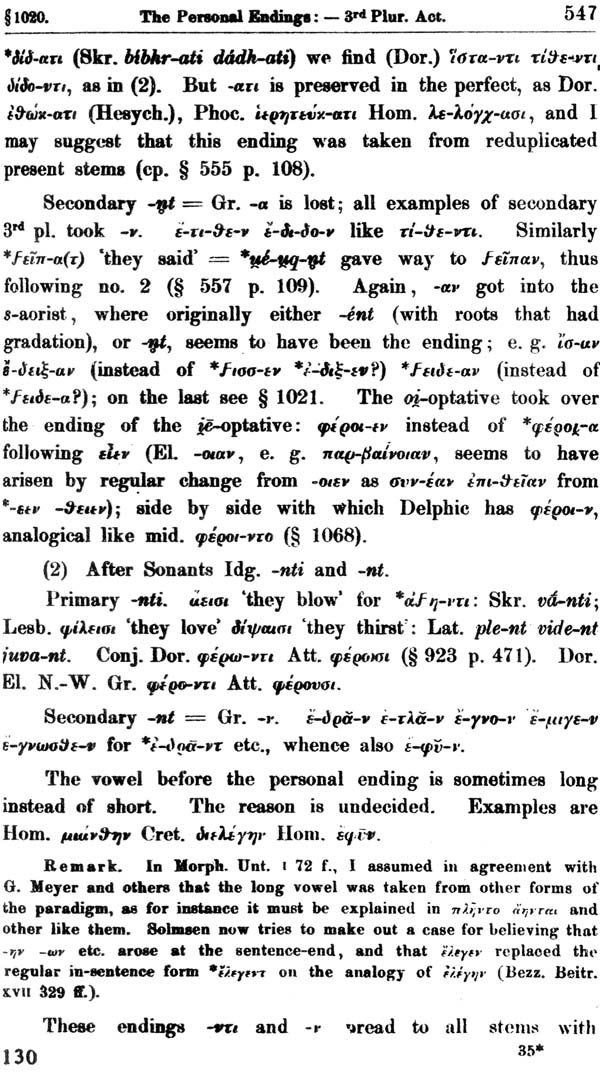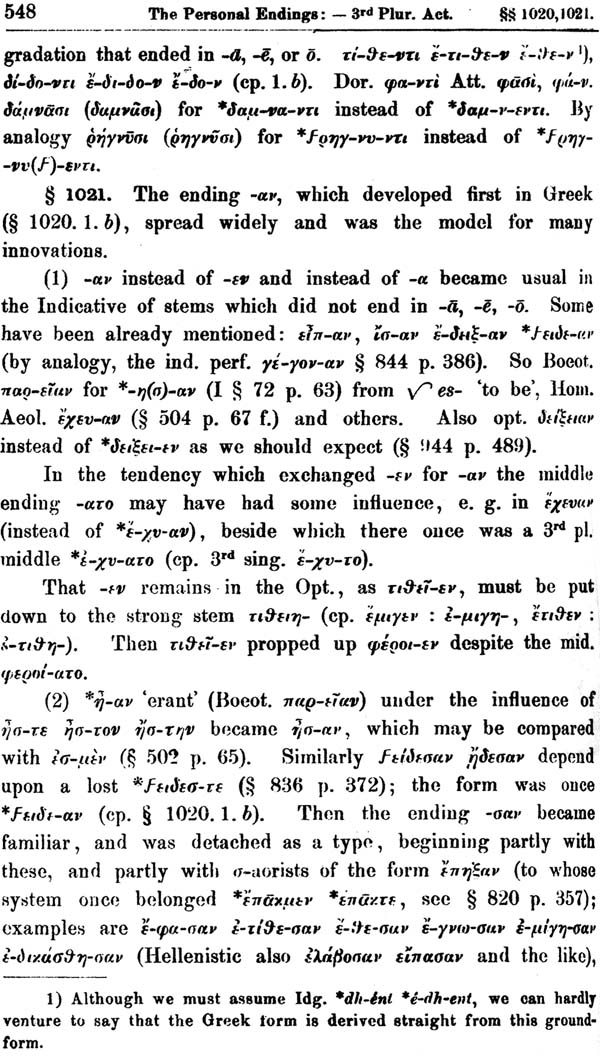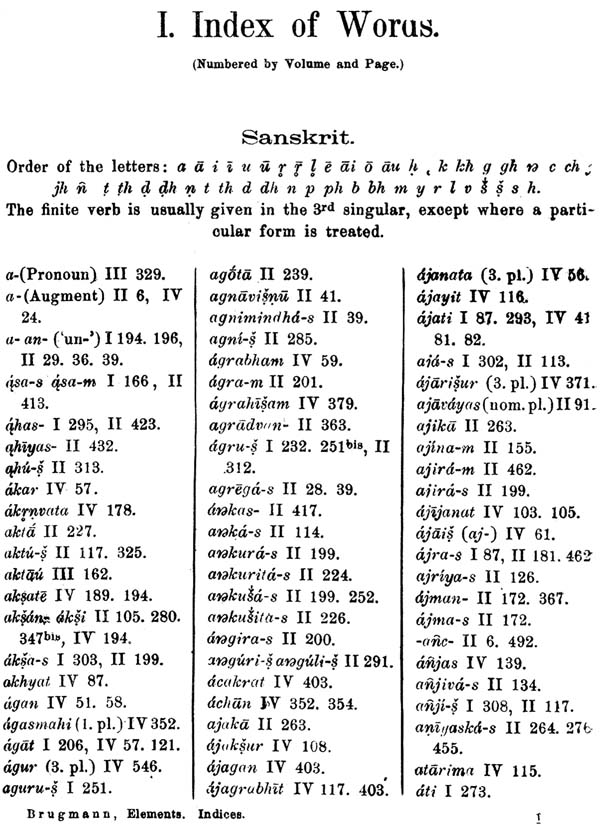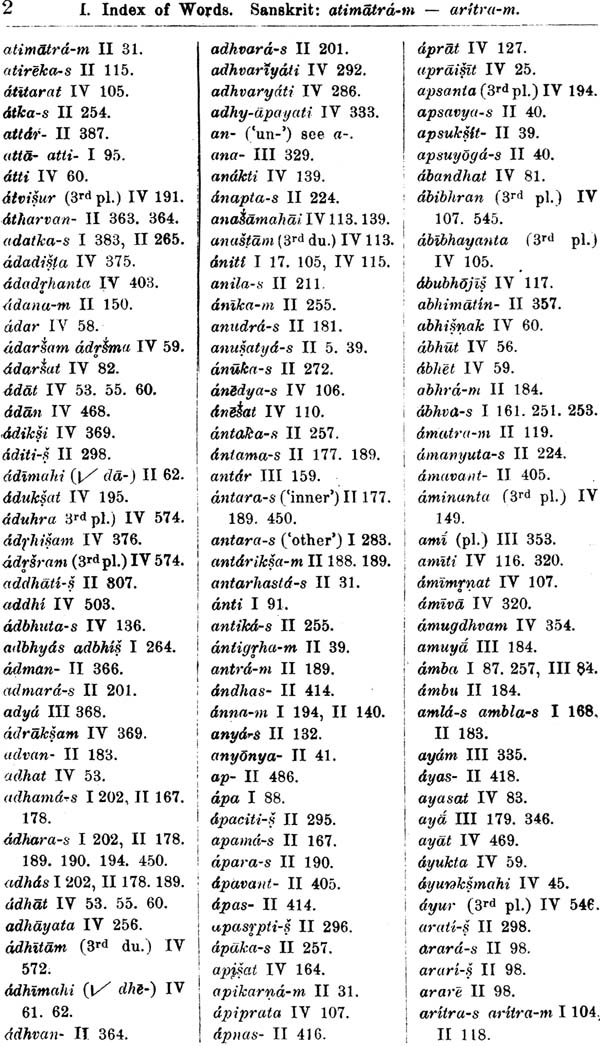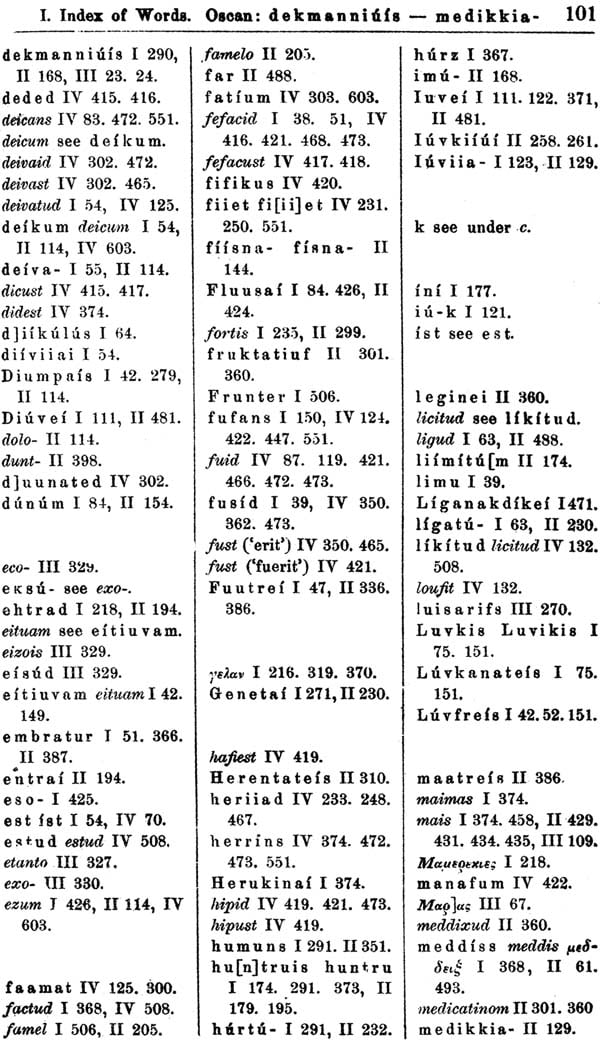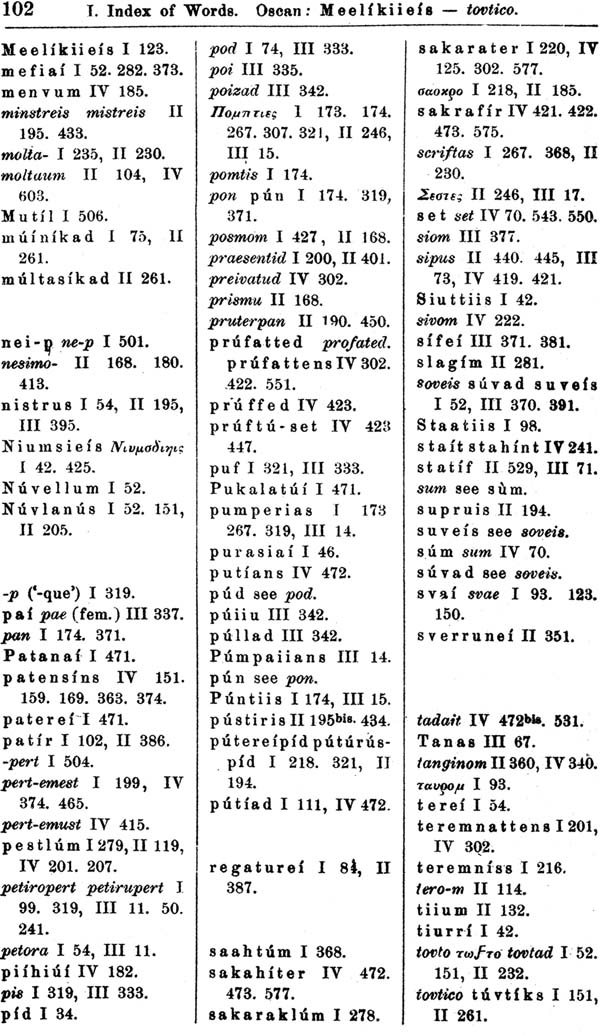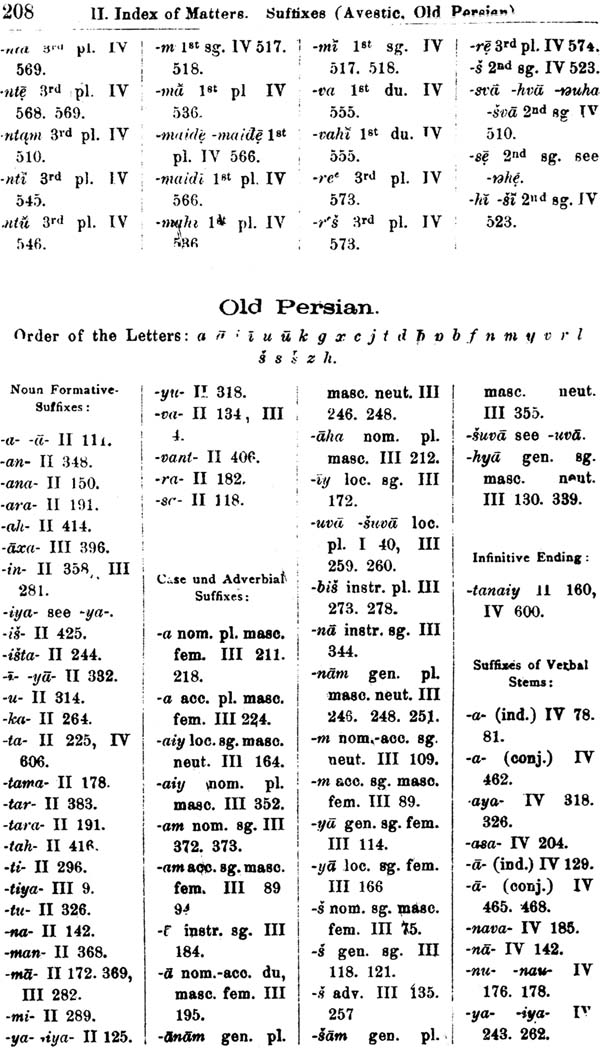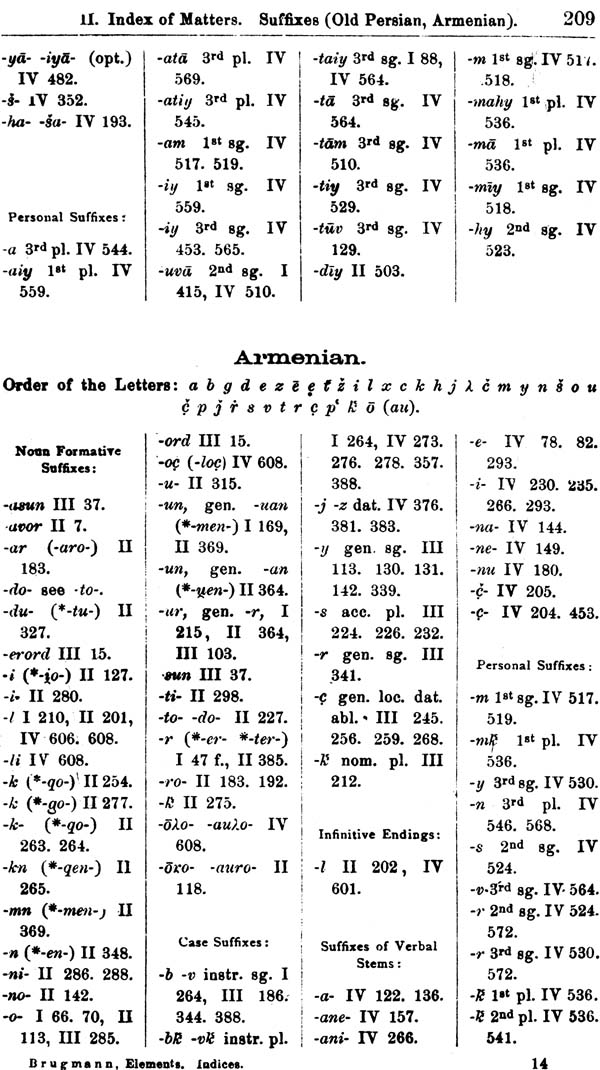
A Comparative Grammar of the Indo-Germanic Languages - 5 Volumes
Book Specification
| Item Code: | IDF515 |
| Author: | Karl Brugmann |
| Publisher: | Chowkhamba Sanskrit Series Office |
| Language: | English |
| Edition: | 1972 |
| Pages: | 2397 |
| Cover: | Hardcover |
| Other Details | 8.8" X 5.5" |
| Weight | 3 kg |
Book Description
(A Concise Exposition of the History of Sanskrit, Old Iranian (Avestic and Old Persian), old Armenian, Greek, Latin, Umbro-Samnitic, Old Irish, Gothic, Old High German, Lithuanian and Old Church Slavonic)
Publisher's Note :
Elements of the Comparative Grammar of the Indo-Germanic Languages had been a pioneer work in the field of Comparative Philology, and even today remains unsurpassed by any other work, either in its magnitude or in exhaustiveness.
The author has incorporated almost all the contemporary material on the subject representing all the parties among the different methods and schools of Linguistic Science. At the same time, he has not confined himself to merely stating the contemporary conclusions seemingly certain to stand for all future time. Instead, he has spoken of many problems that are still unsolved in order to give the reader not only a survey of what has been already accomplished, but also to give a glimpse of the work that still remains to be done. This was indispensable in view of the position in which the science of the Indo-Germanic languages at the time stood. Thanks to the discovery of many fresh sources of information, and still more, to the fertile combination which the recent researches have brought about between minute investigation on the one hand and the philosophy of languages on the other new problems to be solved have of late arisen on all sides, and that in such numbers that many decades of work will still be needed to master them. Had the author silently passed over all such unsettled questions in the history of the Indo-Germanic languages the picture of the whole subject which, he has tried to draw would have been marred by many grievous blanks. But thanks to the sincerity of his purpose and his erudition, no such problem remains unsolved or unnoticed. Wherever he is not sure of the solutions, he has not merely marked the phenomenon in question as unexplained, but often hazarded a conjecture, at all events, in something like the direction in which the solution of the riddle is to be sought. The conjectures, he however has admitted, should be regarded only as challenges to more minute investigation.
As regards to the arrangement of the material the scheme followed is to let the different branches of Languages and the separate Languages apart each as a unit complete in itself on the common background of the Indo-Germanic premitive community, yet in such a way that each single phenomenon appears separated as little as possible from the kindred examples in other languages.
Such an important and pioneer work, which remained out-of-print for so many years, is now been reprinted by us even at great risk of investment, solely with the hope and confidence that we are thus rendering a valuable service to the students and scholars of Philosophy who had been long deprived of the work containing a systematic and scientific study of languages based on firm and rigid principles.
Definition of the Science of the Indo- Germanic Languages, and the Division of the Indo- Germanic Family Into Its Various Branches.
$1. The Science of the Indg. languages forms, like indg. Mythology, a section of Indg. Philology , I.e. of that Science, Which has to investigate the intellectual development of the Indg. Peoples form the time before their separation up to the present day. Its method accordingly is historical and its task is to investigate the whole development of the Indg. Languages from the time when they were still one languages down to the present day. Its Unity is in no sense broken by the results furnished by the specialists in Sanskrit, Ancient and modern Greek, Latin and the Romance languages, Keltic etc., for the science of the Indian languages, of Ancient and Mod. Greek etc. are integral components of the grand whole formed by that of the Indo-Germanic.
It is True That the so called comparative science of language has hitherto been almost exclusively confined to the older periods of the Indg. Languages, but this is due to the division of labour which was involved in the limitations of human strength. Probably the same division of labour will still be necessary, but it implies no real opposition between the different parts of the science.
Compare the author’s address ‘Sprachwissenschaft und Philologie’ ( in his ‘Zum heutigen Stand der Sprachwissenschaft’, Strassburg 1885 , p. 3 ff.).
$ 2. We are not at present in a position to determine finally what was the primitive home of the Indg. Tribes. Only so much is Clear, that these tribes in pre- historic times must has been far less widely diffused than they were at the beginning of the historic era. It was formerly usual to place this primitive home somewhere in Asia, where as at Present scholars lenu rather to the opinion that the Asiatic members of the stock Prasad over form Europe. Cp. O. Sprachvergleichung und Ugreschichte , Jena 1883, p. 442 ff.
$ 3. It is Impossible to suppose that a language should have gone through a long Course of development, and be spoken by a people of any Considerable numbers, without a certain amount of dialectical variation; and hence we cannot look upon the speech of the Indogermans, even while they still occupied a comparatively small territory and maintained a fairly close degree of intercourse with one another, as bearing in any strict sense, a uniform character. Local differences had no doubt already arisen, through actual instances of this have hardly as yet been established with perfect certainly. One Such I have maintained, though only as a conjecture, in 380 , 417. In historical times there appear a Multitude of dialects, diverging in a greater or less degree, the whole field o which can hardly be included in any one survey. We may take for granted that the differentiation of dialects about the year 2000 B.C. had gone so far, that a number of communities existed side by side, which could no longer , or only with difficulty understand one another. The historic record of the various individual developments beings at very different periods. E.g. the Indian development is known to us from about the Year 1500 B.C. onwards, the latin from about 300 B. C. the Irish Since the eighth century of the Christian era (with the exception of the Ogam inscription, cp. 9), and the Lithuanian from the middle of the sixteenth century.
A number of separate developments, which sprung from the primitive Indg. Language, have perished without leaving any traces of their existence. Of others we have only very scanty fragments left, on which it is scarcely, if at all, possible to found a grammar, as of Phrygian, Macedonian, Messapian, Gallic, and Burgudian. The remainder have come down to us with a more abundant supply of material. The dialects belonging to this last class, are arrange in to eight groups (branches of language): 1. Aryan, 2. Armenian, 3. Greek, 4. Albanian 5. Italic 6. Keltic, 7. Germanic, 8. Balticslavonic.Each group is distinguished by the fact that its individual members show in common a considerable number of changes in sound , inflexion, Syntax and vocavulary ; e.g. the shifting of the prim. Indg. Explosives, discussed in 527 ff. (what is known as the first sound –shifting ), is one of the numerous characteristics of the close relation existing between the Germanic dialects.
Of the dialects, which can be assigned with certainly to one or other of these eight groups, e.g. the Burgundian to the Germanic, and the Gallic to the Keltic group whilst others , e. g. the Macedonian, seem to belong to none of them.
It is in itself very possible that some of these eight chief members stand to each other in a closer relationship, and form a single group historically distinct from the rest. All Attempts, however, to establish such a closer relationship, have hitherto proved futile. The Italo – Keltic hypothesis has perhaps the best prospect of attaining a greater degree of probability in the future.
In Consideration of the length to which the second volume of this Grammar was likely to extend it seemed desirable to publish it in parts)Those which are still to appear will first complete the Morphology of Nouns and pronouns, including the history of the Case – Endings. The Latter section will comparatively brief, since the ablaut of the inflexional syllables has been discussed in all its most important points in connexion with the Formative Suffixes. Then will follow the Morphology of verbs (stem – Formation and Inflexion ), and finally a list of Additions and corrections to the first Volume, [and an Index to both].
A third and last volume of smaller dimension will contain the Syntax. In this part of Comparative Grammar very little work has been done, at least very little work has been done, at least very little that can be called scientific, and hitherto no one has tried to give any systematic account of the subject as a whole. For a long while, I confess, I could hardly make up my mind to include it in the present work, but I have been greatly encouraged to make the attempt by the appearance of the fifth Volume of Delbruck’s Syantaktische Forschungen ( Altindische Syantax 1888 ), which, though it is not directly concerned with comparative Grammar, has done a great deal to prepare the way for a general history of Indogermanic. And in my work for the third volume I hope to have the help of O. Behaghel’s Grundzuge der germanischen Syantax which has been announced for some time.
I have Accepted as necessary one or two alterations in the transcription of Avestic ; instead of (before see vol. I 558 p. 415), for all three sings s,s and s. As regard these sibilants we ought still, in all probability, to make some distinction between the sounds in such words as histaiti = Skr. Tisthati ( I 556 p. 410), masya = Skr.martiya – (I 260p. 212 f.474 p. 350), syaopna = proethnic Aryan ciautna (I448 p. 333, 473, 4p. 350) I accepted with other scholars the theory whichBartholomae advanced in Bezzenberger’s Beitrage VII 188 ff. as to the respective value of these three sings in the zend alphabet, and , so far as I can see, It is not disproved by Gelender’s recent edition of the Avesta. At the same time it is certainly not confirmed by the results of glender’s work and Bartholomae himself, with Hubschmann and others, now follow him in writings s indifferently in all cases. Thus I had no alternative.
In Celtic Prof. Thurneysen has given me the same generous assistance as in the First Volume. My Pupil Dr. W. Streitberg has helped me in correcting the proof. To both I may here offer my hearty thanks.
In this volume I have used, though sparingly, the terms suggested in the preface to volume II - re-formate (formate), ad-formate. transformate. These are applied to single words: as on p. 30, Rem. 1. When a word is modified by the analog)' of another, it is said to be an ad-formate of it (p. 29, line 7 from the bottom, is an example). In its new shape it is transformed. from the old, or a transformate of it (p. 44: footnote).
Absolutely regarded, it is a re-formate (sometimes, where there can be no mistake, the simple word formate stands). Re-formation and transformation are used when not single words, but groups, come in question (as p. 90, line 6 from bottom); also when certain sound changes are exemplified by the words cited (as the z in sibunzo ahtoeo, p. 40). These terms may by ugly, but they are so very convenient that their ugliness will, it is hoped, be forgiven.
In such words as Pau, Prakrit, Gathic the quantity has not always been marked. It seemed needless to do so when this had been indicated often enough to ensure its being remembered.
The word polysyllable is used to include dissvllables. unless otherwise implied.
I had hoped to get out this Volume by Christmas last. The delay is due partly to the waste of time in sending proof to and fro form Germany, and Partly to the almost ceaseless pressure of other duties.
Mr. Conway’s criticism and advice has been very useful all through and I take the opportunity of thanking him for it.
The list of Additions and Corrections given in the concluding part of the German edition have been here put in their proper place in the text. Some few alterations have also been made, with Prof. Brugmann's sanction, by way of making Clear what from its terseness might have been misunderstood. list of misprint- is given, but I fear there must be others ; I hope that these will be forgiven, in view of the exceeding difficulty of correcting proof with so many different diacritic marks.
It may he well to point out that the word "Re duplicator" has been used as equivalent to Reduplicating Syllable or Syllable of Reduplication j and that "Phrase" has been extended to apply to a short complete sentence which fuses into a single word, RS fere-bam, datasmi (see page 444). In this volume as before I have to thank Mr. Con way for valuable help.
The Indices are nearly ready, and it is hoped they may be publisht along with this volume, or at least with small delay thereafter.
In the treatment of Phonetics and Morphology in work.' so many words are cited along with parallels words etymologically connected, that the book may be to this extent in the study of etymology. To this end Index of Words has been compiled, including as it does I than mere grammatical forms. I, would also observe that I have somewhat departed from the usual methods of such indices, because very few of those who use it will be equally at home in all the languages therein contained, and many may look for words out of a language whose paradigms not familiar to them.
For the Index of Matters two limitations have set. If it contained all the processes described, in the samedetail as we find in the indices to our periodicals, or in any other conceivable form, not only would this have taken up much space, but what is more to the point , it would been hardly easier to find one's way about by means of the index than can be done by aid ,of the very full Table Contents to Volume I. I have therefore, with certain fewexceptions, excluded the processes of sound change. on the other hand. the idea of giving all the examples of Analogy in all its kinds was given up, chiefly for lack of space. Theheadings given are those only which the student is most likely to look for, such as Popular Etymology, Assimilation of Opposites, and the like. In these last I have had much help from lists of the examples for Analogical Re-formation, given in Vols. I and 11, which where compiled by my pupil E. Kleinhans, and very kindly' placed at my disposal.
Volume - I
| INTRODUCTION | ||
| Definition of the Science of the Indo-Germanic Languages, and the Division of the Indg. Family of Languages Into its various Branches | 1 | |
| On the Structure of the Indg. Languages in General Root and Suffixes | 13 | |
| PHONOLOGY | ||
| The Sounds of the Indg. Primitive Languages | 19 | |
| Phonetic Elucidations | 20 | |
| On the Pronunciation of the Letters | 22 | |
| History of the Separate Prim. Indg. Sounds. | ||
| The Vowels | 30 | |
| Nasals | 162 | |
| Liquids | 207 | |
| Ablaut (Vowel Gradation) | 244 | |
| Explosives | 261 | |
| The Spirants | 407 | |
| Other Combinatory Sound-Changes | ||
| Contraction (Hiatus, Elision) | 453 | |
| Shortening of Long Vowels | 461 | |
| Lightening of Short Vowels | 465 | |
| Anaptyxis from Consonants | 468 | |
| Vowel Absorption | 473 | |
| Palatalisation and Labialisation with Epenthesis | 477 | |
| Loss of Styllable By Dissimilation | 481 | |
| Sandhi (Satzphonetik) | 483 | |
| Accentuation | 527 | |
| Additions and Corrections | 562 | |
| VOLUME II | ||
| MORPHOLOGY (SYSTEM-FORMATION AND INFLEXION) | 1 | |
| 1. | Suffixes in -o- and -a- | 109 |
| 2. | Suffixes in -i- | 278 |
| 3. | Suffixes in -u- | 311 |
| 4. | The Suffix -i- (ie-) | 332 |
| 5. | Suffixes in -n- | 340 |
| 6. | Suffixes in -r- | 375 |
| 7. | Suffixes in -t- | 389 |
| 8. | The Suffix -d- (-ad-) | 407 |
| 9. | The Suffix -k- and -q- | 410 |
| 10. | The Suffix -g- (and -g-?) | 411 |
| 11. | Suffixes in -s-. | 411 |
| VOLUME III | ||
| The Numerals | 1 | |
| The cases of Nouns | 52 | |
| Pronouns | 322 | |
| VOLUME IV | ||
| Verbs | 1 | |
| The Mood Stem | 456 | |
| The Verb Infinite (Verbal Nouns) | 594 | |
| VOLUME V | ||
| Index of Words | 74 | |
| Index of Matters | 175 | |
| Index of Authors | 234 | |
| Addenda and Corrigenda | 246 | |
